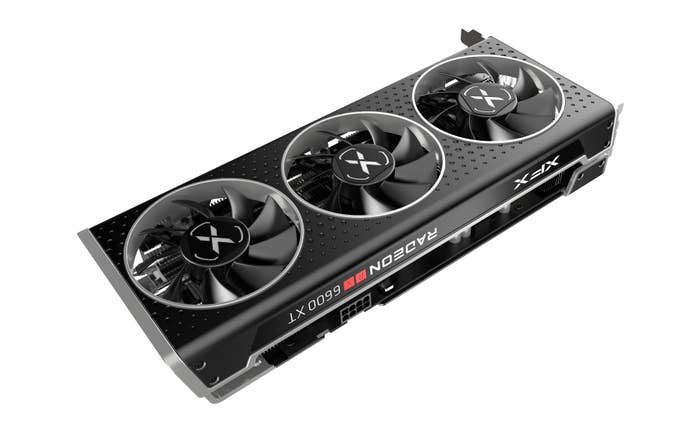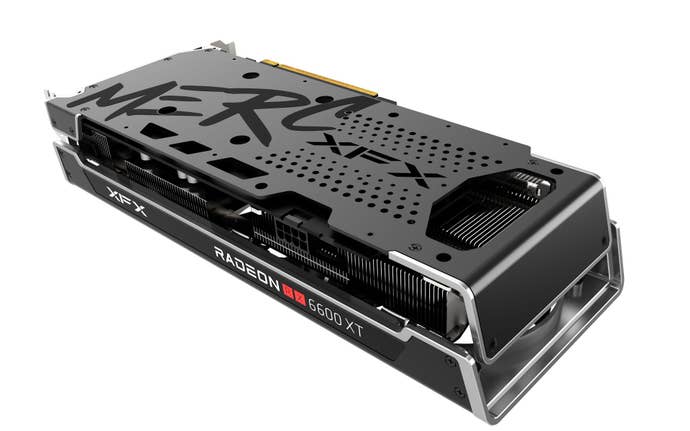AMD Radeon RX 6600 XT review: a 1080p natural - just don’t turn on ray tracing
If you’re looking for a solid entry-level GPU, AMD’s latest offering in that bracket is a strong card that’ll deliver great 1080p performance.
In the ongoing battle between PC graphics powerhouses AMD and Nvidia, it’s often easy to focus in on the most powerful cards. Which is the best at 4K, with everything cranked up to Ultra, and ray tracing activated? And, I mean - why not, it’s fun, right? Almost everybody would love to drive a Bugatti. But the reality, we know, is that a lot of people are looking for that nice middle ground: a graphics card that’s going to offer great gaming performance within the confines of their own setup, and without breaking the bank.
It’s this category where cards like the recently-released AMD Radeon RX 6600 XT reside. This is AMD’s answer to the Nvidia GeForce RTX 3060 and 3060 Ti, battling it out at the entry-level point of the market - below the $400 mark at RRP. Yes, I know it’s still incredibly difficult to get these cards at RRP - but we have to assume the market will eventually normalize, and so we continue to review them at their standard price rather than the scalper-inflated costs.
So, where does the RX 6600 XT sit among its rivals in that great entry-level pantheon? Well, it’s sort of slap bang in the middle, which might be exactly what some want.

What I mean by that is that in tests we’ve run, the RX 6600 XT often just squeaks past the RTX 3060 - with frame rate boons of anywhere from 5% up to as much as 15%. This comes with several notable caveats, however.
First of all there’s the price - at RRP ($379/£329), the RX 6600 XT is $50 more expensive than the RTX 3060 - so you have to measure up if that performance increase is worth the extra outlay for you. Then there’s the option of the 3060 Ti, which turns the tables back in Nvidia’s favor for a further extra $20 or so.
The other major caveat is ray tracing. Nvidia has those custom ray tracing cores that it’s done so much boasting about - and they definitely do make a difference. In every ray tracing game we tested (Metro Exodus, Cyberpunk 2077, Control), the 6600 XT was outperformed by both of the Nvidia cards of a similar class. Take ray tracing out of the equation, however, and AMD’s offering outperforms the RTX 3060 in many cases and at an absolute minimum, or at least matches up to Nvidia’s effort.
Like I said, it’s a card of caveats. You can happily run things like Gears 5 and Hitman 3 on Ultra settings and get well in excess of 100fps. A hop to a more intense open-world affair like Assassin’s Creed Valhalla and I still saw a solid 60fps. Control is in the former category, around 100fps, without ray tracing activated - but it plummets to below 60fps with that snazzy lighting turned on. It’s there where the gap between this card and Nvidia’s widens - and not in the right direction.
All of this testing was done at 1080p, but a similar picture is painted at 1440p also - just slice 30% minimum off the numbers. Bumping to higher resolutions results means dropping ray tracing unless you’re willing to accept some very bumpy performance, too - but the same is broadly true right across this class. Make no mistake that this is a 1080p card first and foremost - that’s the resolution where you can enjoy frame rates in excess of 60fps on modern games - but if you’re willing to accept frame rates that might dip a little below 60, this is a totally valid 1440p card, too. I’d primarily recommend it for 1080p, however.
The design of the card you get will vary depending on the vendor, of course, but they’re generally speaking all similar to the card we tested, which is from XFX: three fans and a fairly chunky design that actually feels a little oversized, given the power level of the card. That means that cooling won’t be a problem, however - and in addition, the card only requires a 500W PSU, marking it as one of the lowest-draw options on the market for modern gaming.
This is a good card. It’s teetering on great, however, depending on your ability to swallow the industry-wide price creep on GPUs; this sort of category entry-level was around half the price a decade ago. That creep is an industry-wide deal, though - and when compared to its peers, the Radeon RX 6600 XT is proof that AMD is finally beginning to match up to and take the fight to Nvidia.

Where the Nvidia cards have the advantage is in some of these shiny new features. Ray tracing is clearly a problem, though it also undoubtedly isn’t the biggest priority for somebody in the market for an entry-level, 1080p-first card. Even if you put that to one side, however, Nvidia is also boasting features like its Broadcast suite and DLSS. The latter is particularly important, as in supported games, turning DLSS on will make the 3060’s frame rates streak from behind the 3600 XT to decently ahead. AMD has its own version of the latter, FidelityFX Super Resolution (FSR) - and it looks promisingly powerful - though ultimately it’s still behind DLSS, playing catch-up both in terms of supported games and the quality of the upscaled image it provides.
How do you feel about these new-fangled bells and whistles, then? We’ve made pretty clear in past reviews that we do rate a lot of what Nvidia is doing with its RTX series GPUs - and the green is clearly ahead of the red in those terms. But as a belt-and-braces graphics card looking at raw performance, the RX 6600 XT is ahead of the RTX 3060 - it’s a better-value card overall. You’ve got great 1080p performance and decent 1440p performance. Begin to factor in ray tracing and DLSS and things get ugly, however - especially if the 3060 Ti is within your price range.
The RX 6600 XT feels like a stepping stone of a card, in a sense. It’s a perfectly respectable option, and for those whose PC gaming circumstances fit its feature set, it’s easy to recommend as decent value. At the same time, this card does have the whiff of one step in a larger story - that of AMD gradually fighting back and becoming competitive with AMD once again. It’s a step in the right direction, too. In the current GPU market where you have to take what you can find in stock, I wouldn’t dissuade anybody desperate for an upgrade from picking up this card - but if I’m being honest, what I really want to see is where the AMD & Nvidia war is at in another generation.





_ddwYK80.png?width=291&height=164&fit=crop&quality=80&format=jpg&auto=webp)



